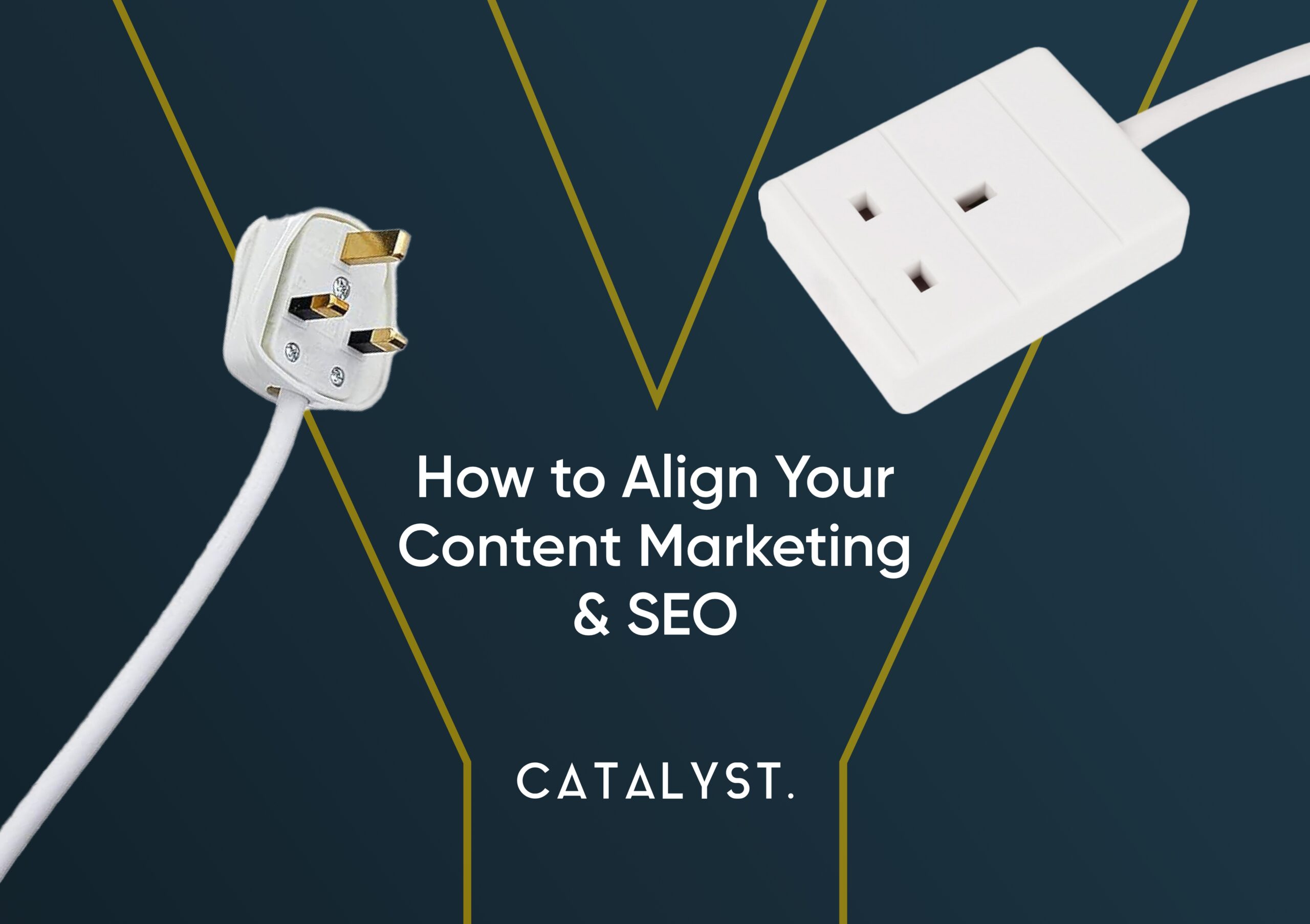By this point, you probably understand the importance of content marketing and the impact it can have on your website’s lead generation success.
However, a mistake many businesses make when planning their content marketing is that they neglect to optimise content alongside their SEO (search engine optimisation) strategy.
Content marketing and SEO strategies go hand in hand. One rarely works without the other, so it’s crucial that you align your content marketing with your SEO now and into the future.
In this blog, we’ll detail how you can align your content marketing efforts with your ongoing SEO strategy, helping to drive more viewers to your blogs and content, boost your keyword rankings and drive more warm leads to your sales team.
Keyword research for content marketing
Keywords are essential in any content marketing or SEO strategy.
Our clients are often surprised when they find out what their audience are actually searching for. We recommend using keyword analysis tools like SEMrush, MOZ or Ahrefs to comb through keywords and identify the words and phrases that will help you produce better content.
You’ll need to regularly revisit your keyword research to ensure its continued success. See what blogs/content drive the most traffic, identify which keywords you’re already ranking for and see if there’s anything you can do to boost them in SERPs (search engine results pages).
When performing keyword research for content marketing, you should break your keywords down into two categories:
Short-tail keywords
Short-tail keywords are broad and relatively generic. They have a higher search volume than long-tail keywords, but are much harder to rank for.
Say you run a clothes shop online. Your short-tail keywords might be “shirts”, “jeans”, or “ties”.
Sure, these kinds of words are important for you to feature, but you’re unlikely to see any significant traction for them. Where you really start to see results is with your long-tail keywords.
Long-tail keywords
Long-tail keywords are search queries that get significantly lower volume, but often have much more intent behind them.
For example, “Red men’s shirts”, “Women’s bootcut jeans”, or “Formal ties for weddings”.
If your content centres specifically around your long-tail keywords, you’ll find more success. You should also consider how people are searching on Google and other SERPs now.
For years, people have typed questions into search engines, but more often than not, modern users are using voice search engines, such as Siri or Alexa, to find answers to their questions.
As a result, keywords that work are often questions and full sentences. Use the aforementioned keyword analysis tools to help you find questions that people are asking, and make sure that you answer them, in full, in your content.
Add keywords to your blogs/content marketing
This one might sound a little obvious, but hear us out.
Most people forget to add their keywords throughout their blogs! The keywords you’re targeting need to be in your blog’s title, the main body content, in the URL, the headings, the meta description, the page title – everywhere you can put it, do so!
Here’s a little peek behind the curtain for you:
On this blog, we’re targeting the keyword “content marketing”. You want to avoid overusing the keyword, but you need to ensure that it’s featured in all the right places, and fits naturally into your main content.
Have a look back through this blog, or continue reading and see where you can spot this keyword. Now that you know, it’ll become painfully obvious, but the point is to write in such a way that it seems natural – the average reader is not going to notice when and where you’re featuring your keywords!
Link to your other content where appropriate
This is easily forgotten, but very important to your SEO strategy.
If you mention a service, or another page on your website – LINK TO IT! If you mention research or quote another website – LINK TO IT!
Internal and external linking is incredibly important to SEO success. It provides a pathway for Google’s crawler, named Googlebot, to find your website and, more importantly, to understand your website.
This bot has one purpose: to help websites index properly on Google. By linking to relevant content, you’re helping the bot develop a solid understanding of the structure of your website. A well-structured website is a better website, and Google prefers to push only the best content to its users.
That is why linking is so essential – it can and will help your content to rank better on SERPs.
Use technical SEO practices on every piece of content
It’s relatively easy to throw a blog together and upload it to your site, but if you forget to use technical SEO practices, then your content marketing strategy will often fall a little flat.
By “technical SEO practices”, we mean:
Keyword-rich meta descriptions
Your meta description is the small section of text that appears under the link to your content on search engines.
Your meta descriptions should be 155 characters (with spaces). They should feature the keywords you’re targeting in your content, and should give a brief explanation of what the viewer might expect if they click the link above.
Better meta descriptions have proven to drive roughly 6% more clicks than those with poor or automated meta descriptions (ones provided by Google), so it’s worth taking the time to write them!
Image alt tags
Every image you feature in your content will have a small section of text called its “alt tags”.
This is a small snippet of text describing the image. This is used by SERPs to index images on image search functionality.
Lots of content gets clicks through image search, so don’t neglect your imagery SEO!
Rich snippets
Rich snippets are enhanced search results displayed by search engines. They often feature additional information above the page title and sit above the fold (also known as position 0).
If you can get a rich snippet, your content will sit above everyone else.
The above is an example of what a rich snippet looks like. When you’re addressing your keywords, make sure to include a concise definition/description/answer to your question.
You can also add schema markup to your HTML code to help search engines more easily understand where rich snippets can be found.
If you need help with this, don’t hesitate to talk to our SEO experts today.
Adjust and update existing content
Chances are, you have a broad library of content that already exists and already has search equity. If this is the case, this is a great place to start when revamping your content marketing.
For example, if you’ve written a blog that’s sitting around position 3-5 on SERPs, consider what you can do to that blog to help boost it up the rankings. This can be as little as featuring your keyword/phrase a little more in the blog, editing the content to be a little more engaging or informative for the reader, or refining your technical on-page SEO.
Many businesses “set and forget” their content. Google prioritises content that is regularly updated, so always take the time to revisit older content when possible!
Analyse, test and refine results
No content marketing success is found without data, amendments and testing.
Identify what content is getting engagement, if possible, identify why it’s getting great engagement. Use this data to help build out a content plan. Identify:
- What CTAs (calls to action) people are clicking on
- What keywords are resonating with your audience?
- What tone of voice and writing style gets the best engagement?
- How long are people staying on your content pages?
- What are the bounce rates?
Data fuels success – this is extremely important in content marketing and ongoing SEO strategies. Take the time to analyse where you are before you strive to improve.
Need help aligning your content marketing with your SEO?
Managing an ongoing content marketing strategy is taxing. There’s a lot of research, writing, refining and behind-the-scenes technical wizardry that goes into making it work.
Don’t have time? Most businesses don’t – that’s why they leave the content marketing to the experts – our specialists at Catalyst.
We’re a commercially focused digital marketing agency based in Birmingham. We create content marketing strategies that centre around driving more traffic, boosting your website’s SERP rankings and delivering warm, relevant leads that are ready to convert.
It’s our goal to deliver an ROI above all else. Let’s grow your business together. Click the link below to speak with a content marketing specialist.
Speak to a content marketing specialist

